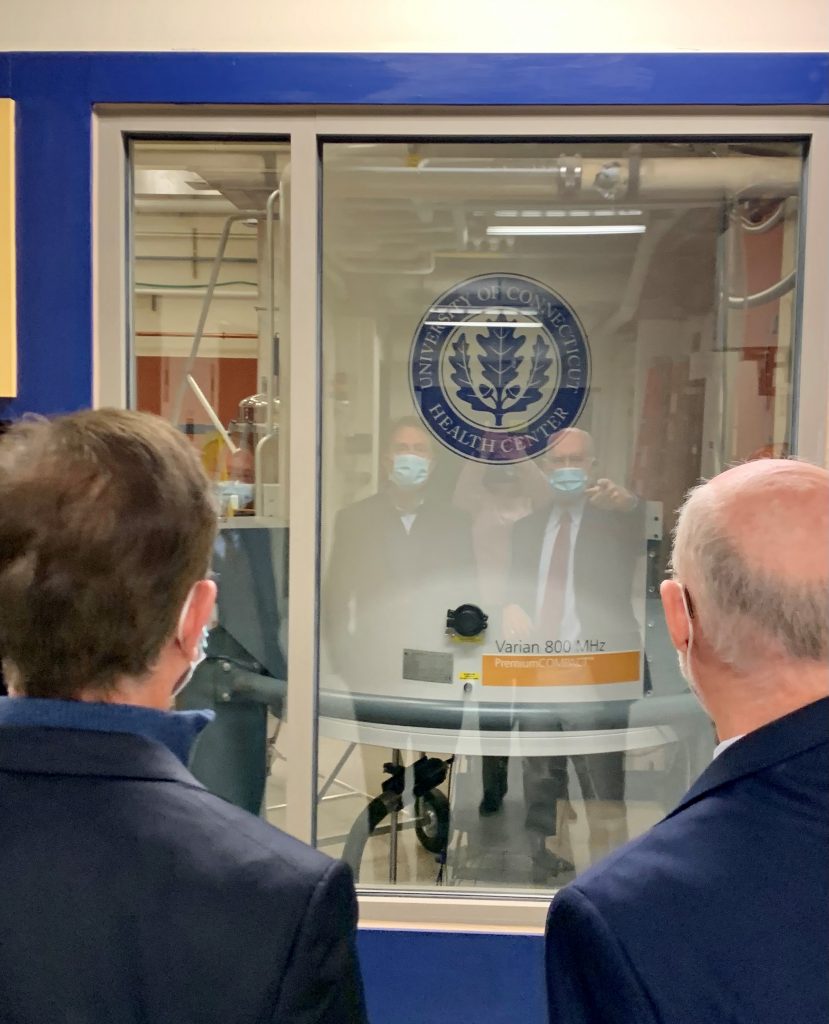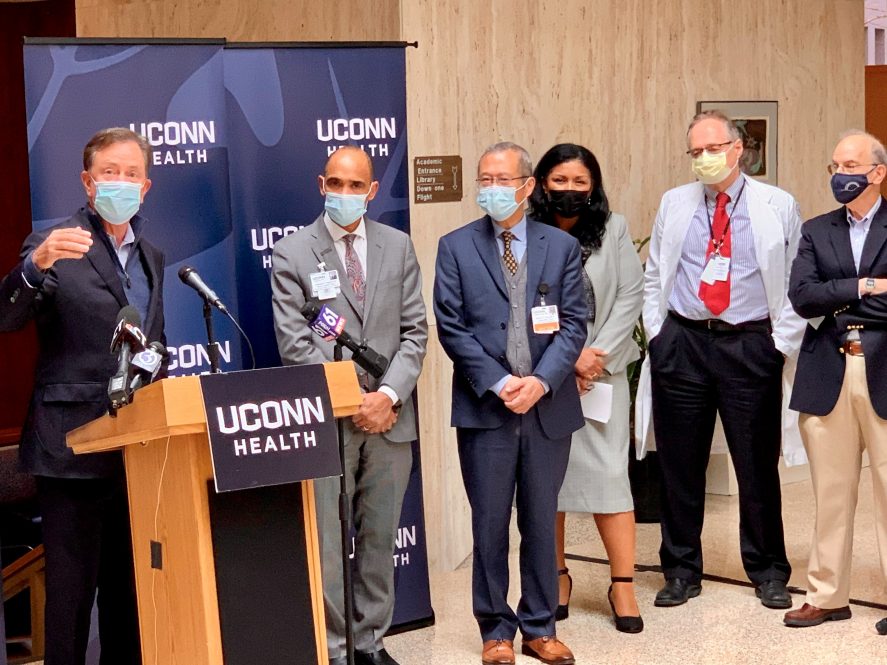Gov. Ned Lamont and state legislators visited UConn Health on Monday, Nov. 1 to tour its state-of-the-art research facilities, and to celebrate record funding for UConn researchers over the past fiscal year, with $375 million in federal, state and industry grants and awards. Following the tour, Lamont held a news conference in the Academic lobby, joined by both UConn and UConn Health leaders and researchers.
Lamont and guests visited the Nuclear Magnetic Resonance (NMR) Facility, where they met with Jeffrey Hoch, director of the Gregory P. Mullen NMR Structural Biology Facility, and Mark Maciejewski, assistant professor of molecular biology and biophysics, who manages the facility. Hoch and his team are recent recipients of a $40 million grant by the National Science Foundation, the largest grant in UConn history.

Hoch and Maciejewski showed the governor and legislators the facility’s powerful research magnets, and new liquid helium recycling technology. The $40 million grant is helping create a national Network for Advanced NMR, a powerful research method for analyzing molecules.
The area housing the helium liquification plant also includes superconducting magnets. The magnets, which are the “heart” of the NMR instruments, require liquid helium to cool them to 4° Kelvin, or 4 degrees above absolute zero, Hoch explains.
“Until recently, helium, which is increasingly expensive and in short supply, was lost to the atmosphere,” Hoch says. “With this liquification plant, we now capture the helium gas as it boils off from each of the four instruments in the facility. It is compressed then processed by a purifier and compressed again to liquefy it before being reused. We expect to be able to recycle more than 95% of the helium we require, greatly reducing costs and making the facility much more sustainable.”
The group joining the tour included Dr. Andrew Agwunobi, CEO of UConn Health and interim UConn president; Michelle Williams, UConn associate vice president for research; Dr. George Kuchel, director of the UConn Center on Aging and new Claude D. Pepper Older Americans Independence Center at UConn, Travelers Chair in Geriatrics and Gerontology at the UConn School of Medicine; and Leslie Loew, UConn Board of Trustees Distinguished Professor, the Boehringer Ingelheim Chair in Cell Sciences, and professor in the Department of Cell Biology, UConn School of Medicine.
Dr. Bruce Liang, UConn School of Medicine dean, and Anthony Vella, senior associate dean for Research Planning and Development, UConn School of Medicine, participated in the tour as well. They were joined by two state legislators, Representatives Mike Demicco and Tammy Exum, both representing Farmington.
Following the tour, Lamont praised UConn and UConn Health.
“We’re saving lives right here at UConn Health, every day at your health facilities and through the important research you are conducting,” Lamont said. “People see the incredible advances and momentum you have achieved, and they want to be part of it, and support it. The significant research funding you are receiving is a testament to the great work being done here.”
Agwunobi said UConn’s core mission as the state’s flagship public university is to create knowledge that will transform health care and other fields, as well as lead to sustainable economic development for Connecticut.
“Today we are growing research faster than we ever have,” Agwunobi said. “This past fiscal year, our faculty across Storrs, UConn Health, and the regional campuses were successfully awarded $375 million dollars in new awards from external sponsors such as federal agencies, state government, and industry. In total, 746 proposals submitted by UConn faculty were selected for one-time or multi-year funding. This is the highest level of research funding ever achieved at UConn, and we’re hoping to double that in the future to make an even greater contribution.”
Kuchel spoke to the recent federal funding received by the UConn Center on Aging to advance geroscience research, while Williams reiterated the importance of research funding across the University, and how research investments are top priorities.
“Our record growth is also the result of investment,” Williams said, “especially investment in research infrastructure and support. We have invested in state-the-art equipment and research facilities; we have invested in multidisciplinary centers and institutes that are nationally and internationally recognized; and we have invested in outstanding faculty, students, research professionals and staff, who are at the cutting edge of research, scholarship, and creativity.”



